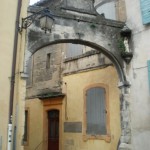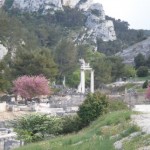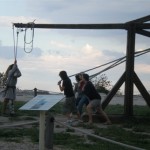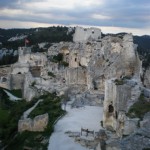Arles and around
Although I would have appreciated waking up later today since we need not rush, the sun was already shining brightly in the sky by 7am. The sky turned truly black only close to 10pm the day before, which was rather unnerving for me. Unwittingly, I realized how much impact sunlight actually has on our biological systems such that I found myself hungry at all the wrong times.
Joel woke up expelling gobs of green phlegm, which was very worrying. If he fell sick now, neither of us would be able to enjoy the rest of the trip. We bought breakfast from the boulangerie across the road. It is one of those cliche experiences you needed to try when you are France. The pastries were really delicious but dreadfully cold in this chilly spring morning. It will take getting used to.
Since we had to wait till 10am to enter Les Arenes, we spent the early morning strolling through town to the only park where Joel could expend his energies at the playground. The streets were deserted even at 9am on Sunday morning. We were greeted by a few cleaners on their mobile cleaning truck, zipping around town emptying rubbish bins and washing the streets with water laced with disinfectant. I was quite amused to see locals performing these jobs and they did so with such pride. In Singapore, we outsource this basic duties to foreign workers and regard them lowly.

Arles is wonderfully pleasant town. It feels like a place locked in an era when time moved slowly, people were welcoming and without barrier and its history weaved so tightly into the fabric of everything that goes on around town. The town is artfully preserved, appealing to tourists and yet not accommodative. Even though we had been in town for only one day, I felt strangely at home and we were able to assimilate easily into the community.

Les Arenes, one of the better maintained Roman arenas in this part of Europe, was impressive but its authenticity was undermined by the metal scaffoldings that lined its interior in order to cater to its present purpose of hosting Spanish corridas. It is interesting to note that the present day Arles continues to thrive around its Roman heritage. Many of its ancient buildings and columns have been retrofitted with modern day amenities and converted into present day housing for the townsfolk. While I won’t comment on how safe it is to live in them, I would say that Singapore has much to learn in terms of conservation.
We left town about mid day and drove about an hour to visit another feat of Roman engineering. The Pont du Gard is massive and till today remains one of the highest architectural monument of the Roman Empire. The Pont is surprisingly well preserved through the centuries and stands impressively across the icy cold waters of the Gardon River. It is an exposed part of an ancient aqueduct that once ferried fresh water from the mountains to the Roman towns through the construct of a meticulously calculated gradient at which the aqueduct slopes.

In summer it would probably be nice to swim in the river in the shadow of the Pont. The river banks are made up of rounded stones, worn by its journey through the mountains to be finally deposited here. The park surrounding the Pont is peaceful and picturesque and while there were many other people around enjoying the scenery, we noted that they were mainly locals. We were relieved that we haven’t encountered hoards of tour buses transporting throngs of tourists to this part of France.

At St Remy (ooh, Remy Lebeau), the main attraction centred around two Roman structures – an arch and a mausoleum. While there was a write up on them, it was all in French. Without additional information, it was hard for us to picture what could have been here and why these two monuments were left here in the middle of nowhere. Across the road is a Roman/Greek ruin called Glanum. The pricey entrance fee of 7.70 Euros dissuaded us. However it is possible to catch a glimpse of the area through an eatery.
Once out of St Remy, we started our ascent of Les Alpilles and were rewarded with beautiful mountainous scenery (yes, I am a mountain person) but nothing prepared me for Les Baux.

Les Baux was once a thriving medieval town and chateau in the 11th century which had been literally carved out of the mountain, think Ministerith from LOTR. However today, much of the town has been converted into touristy commercial entities that now occupies the once medieval homes. As it was getting quite late, we hurried through the ‘fake’ town to the entrance of the château which cost us 13.40 Euros.

Up on the château it was freaking cold as the broken walls offered little protection from the winds that swept the plateau but we were rewarded with panoramic breathtaking views of the surroundings. Information boards in English were strategically placed to help visitors pique their imagination on how life was back then. Despite the layer of clothes we piled on him, Joel started to shiver uncontrollably coupled with his increasing restlessness so we had to make a quick exit as it started to rain. The village was ‘closing’ for the day and soon would be deserted as well. What a shame although I would be hard pressed to convince anyone to stay up here.
We had a take away dinner from Quick a local fast food chain. It was quite an experience having to order the meal in broken French as the high school attendant could not understand a word of English. Joel was so tired he slept from 8pm and missed his dinner. He must be feeling the effects of travelling – jet lag, the cold weather and new cuisine. Really hope he acclimatizes soon. One important thing we had forgotten to bring was a thermoflask so I learnt two essential words through my trip in Europe – acqua calda (Italian) and l’eau chaude (French) for hot water.